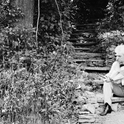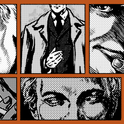Shortly after Justine Triet’s cerebral but emotionally explosive feature Anatomy of a Fall opened in cinemas last year, a brief clip began to surface on social media. In it, the film’s main character, Sandra (Sandra Hüller), chastises her character’s husband, with whom she is locked in an argument: “You are not a victim, not at all. Your generosity conceals something dirtier and meaner…. This is the truth.” In many ways, this memeified scene—a moment caught on tape which Sandra, now standing accused of her husband’s murder, listens back to in court—sums up Triet’s assertions about courtrooms: they are places where getting at the real “truth”, if such a thing exists, is impossible.
Given Anatomy of a Fall’s muted alpine aesthetics and nearly three-hour runtime, the rapt online response to it was somewhat unprecedented—but perhaps not unpredictable. The film is, after all, part of a boom in courtroom dramas. Last week saw, for example, the UK release of The Goldman Case (it was released last year in its native France)—inspired by the real-life case of the Jewish left-wing revolutionary Pierre Goldman (Arieh Worthalter) who, during his own trial, successfully delegitimised the legal system for racial bias and prejudice. In a few weeks (again, after it was released in France last year) we get François Ozon’s The Crime is Mine, which concerns an aspiring actress (Nadia Tereszkiewicz) falsely accused of murder in the 1930s, who then perverts the course of justice to boost her stardom—and utilises blurry gender politics to get off the hook. The Canadian cyber-thriller Red Rooms, meanwhile, which has just left cinemas, contains a scene that could well be the most perturbing onscreen moment in a courtroom yet.
And it’s not just actual movie releases. Last month, the US cinephile’s streaming platform of choice, the Criterion Channel, announced that it would be adding a courtroom drama strand to its collection. Events dedicated to the genre, such as the Festival du Film Judiciaire, are flourishing.
Of course, as the existence of that that festival suggests, our collective appetite for courtroom dramas is nothing new. As early as 1907, the silent short Falsely Accused! saw law and order lost and then restored again in the space of three minutes. An iteration dubbed “law noir” followed—M (1931), Young Mr Lincoln (1939), The Paradine Case (1947)—in which, in the anarchic interwar years, a vigilante form of justice was enforced by mob bosses and crime lords who replaced judge and jury. Trust in the system was rehabilitated in the 1950s and 1960s, when the American film industry wheeled out a fleet of dependable legal heroes, including Gregory Peck’s Atticus Finch in To Kill a Mockingbird (1962), Henry Fonda as Juror 8 in 12 Angry Men (1957), and Henry Drummond in Inherit the Wind (1960). To counter these releases, the shadier side of the law was illuminated by the incorrect verdicts of The Wrong Man (1956) and Witness for the Prosecution (1957).
It is to those last films—the shadier ones—that the current wave of courtroom dramas is most closely related. However, where traditionally the courtroom drama has featured a grand reveal so that viewers are always in the know, this latest cycle tends to dispense with certainty altogether. Movies such as Red Rooms, Saint Omer (2022) and Dog on Trial (2024) collude to push the genre into more unfettered, more ambivalent and, sometimes, more absurd territory.
In the past, the popularity of courtroom dramas has run in tandem with the prominence of real-life trials—indeed, films such as Inherit the Wind, Compulsion (1959) and even Anatomy of a Murder (1959) served to dramatise them. Today, there’s likely to be something similar going on. Not only have had certain prominent trials, some of them ongoing, but there’s also the global MeToo movement and the rise of social media platforms that allow for real-time deliberation of individual cases. All of these factors—and more—have helped to increase public interest in the intricacies of the legal system…
…and in its failings. Films such as Mangrove (2020), The Trial of the Chicago 7 (2020) and The Goldman Case are painfully aware of the social prejudices that plague legal proceedings within and beyond the court. In Saint Omer, a novelist attends the trial of a young Senegalese immigrant, Laurence, accused of murdering her own daughter, not expecting to find the defendant’s bleak circumstances to be so relatable. While these films’ productions predate the Lucy Letby appeals, her case exemplifies how once the question of crumbling systems is raised—whether it’s a racist police force or an underfunded NHS—extreme doubt can take hold. Who is truly culpable, an individual or society?
Many recent courtroom dramas have also accentuated the bizarreness of the tribunal setting. Laetitia Dosch’s directorial debut, Dog on Trial, is loosely based on the case of an actual dog who was charged with biting strangers. Meanwhile, in Anatomy of a Fall, the solemnity of the courtroom environment is brought into relief by the frivolity and flimsiness of the evidence summoned, as the prosecution trawls through all aspects of Sandra’s relationship—her bisexuality, her career success, mild insecurities divulged by her deceased husband to his therapist—to ascertain whether she could be a killer.
While there is nothing light about Red Rooms, there is an absurdism wrought in the grimly close quarters of its courtroom. This divisive film centres on an axe murderer who livestreamed his killings to a paying audience, as well as on the groupies who sit in on his hearing. Through the viewpoint of one of his devotees, Kelly-Anne (Juliette Gariépy), director Pascal Plante pulls us into the depths of digital fandom and true-crime obsession, probing how, when boundaries are so easily breached online, what happens in court can become equally unruly.
Perhaps the renewed interest in courtroom dramas is driven by something similar to this true-crime obsession. The odd marketing of Anatomy of a Fall—its posters emblazoned with the question, “Did she do it?”—misses the film’s point, but does hint at the reason behind its success. That there is no way of knowing whether Sandra… or Laurence… or Kelly-Anne... are culpable means that their cases can never be solved—and so can forever be talked about.
Courtroom dramas are having a moment. Why?
Perhaps recent prominent trials have made people more interested in the intricacies—and failings—of the legal system
September 26, 2024












